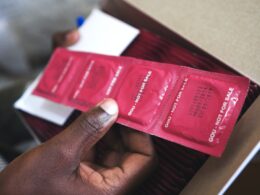As HIV prevention messages have changed, gay men’s condom use has declined. Some men explain their irregularity as forgetfulness, or a desire to avoid ruining a steamy moment.
In NSW and Victoria, where PrEP is available, HIV infections among gay men have reduced significantly. But many still refuse to use condoms.
1. They are a form of protection
Men can use condoms to protect against many sexually transmitted infections, including HIV, gonorrhea, chlamydia, and syphilis. But they also work well to prevent pregnancy, which is especially important for gay men who might have multiple partners and can’t confidently ascertain their partner’s sexual health status.
This reflects an underlying theme in research suggesting that the emergence of highly active antiretroviral therapy-based biomedical interventions has liberated gay men from condoms’ psychological shield, and that their use is being undermined by a sense of optimism about HIV’s transformation from death sentence to chronic illness. This optimism has been bolstered by the Food and Drug Administration’s approval of PrEP, which can be used by HIV negative individuals as a daily pill to prevent seroconversion in case they engage in unprotected anal intercourse with an HIV positive person.
Consequently, despite this newfound optimism and the growing visibility of other prevention options, it is still important for gay men to continue using barrier methods, including condoms, during sex to ensure safer sex. In addition, it’s important to remember that condoms are just a tool and that if the condom doesn’t fit correctly, it will be ineffective for protecting against both HIV and other STIs.
Finally, it’s important to remember that sex education for men needs to be ongoing. Communicating openly and honestly about the importance of safer sex with partners, and talking about how to best utilize barrier methods can make it easier for men to engage in more consistently safe behaviour.
2. They are a form of communication
A condom’s ability to be used in a variety of ways makes it an important tool for communication. It can be worn by either partner during sex, or it can be used to protect a sex toy from bacteria and viruses that could spread between partners when shared. A condom’s shape, texture, and color can also signal a particular sexual desire or attitude. For example, gay men may use a red condom to signal to their partners that they are looking for an intense experience.
However, the use of condoms is not without its challenges. For example, they decrease sexual pleasure for many men and require an erect penis for full protection. Furthermore, they must be used correctly and consistently to be effective. As a result, they are only one part of a comprehensive approach to safer sex and HIV prevention.
The availability of PrEP in Australia has led to a significant reduction in HIV infections among gay men. Additionally, the increased availability of other seroadaptive strategies, such as negotiated safety agreements and viral load sorting, is changing how gay men engage in risk evaluation and safe sex practices. As a result, it is likely that interventions that continue to focus on advocating consistent condom use will be viewed as obsolete in the context of these new options.
3. They are a form of respect
Gay men often feel that using condoms is a form of respect for themselves and their partners. While many people think that the use of condoms is only about birth control, they are also used to prevent sexually transmitted diseases (STIs) such as HIV, gonorrhea, chlamydia, and syphilis. STIs are very common among queer men, and can lead to serious complications.
Some scholars have argued that the three decades of safer sex messaging and interventions have resulted in ‘condom fatigue’ for some gay men, leading to inconsistent condom use. Further, they have argued that the emphasis on sex hygiene and the reliance on barrier methods may contribute to stigma around homosexuality in general, which can also reduce prevention uptake.
Despite the fact that AIDS is no longer an epidemic, the stigma around homosexuality persists. Some believe that AIDS catalyzed a culture of sexual health that has begun to crumble before our eyes, with gay men reverting to their carnivorous sexual selves without regard for the threat of HIV.
Getting accurate, comprehensive sex education can be hard for gay men, and many of them have reported that they do not discuss their sexual orientation with doctors. This can be a significant barrier to getting the health care that they need, including HIV testing. In fact, half of gay men report that their doctor has never recommended that they get tested for HIV. This is a problem, as HIV prevention options have improved since AIDS became a pandemic, with PrEP becoming more widely available and the science of viral load sorting and undetectable = untransmittable (U=U) being established.
4. They are a form of safety
With all the talk about PrEP, it’s easy to forget that condoms are still important for HIV prevention. But the truth is, they prevent many other sexually transmitted infections (STIs) as well. They can also be a very important form of safety in situations where your partner’s sex history or health status cannot be confidently ascertained.
Research has shown that gay men who use condoms consistently are at significantly lower risk of HIV infection than those who do not. However, as other methods of prevention become more prominent, it is critical for future public health and community-based interventions to shift prevention messaging away from advocacy for strict condom adherence toward combination prevention. This will require educating gay men on the variety of sexual health strategies available to them and helping them develop the communication and self-advocacy skills needed to optimize these emerging prevention options.
This study used semi-structured interviews with nineteen HIV negative gay men to examine perceptions, motivations, and experiences with condom use and HIV prevention strategies. Their responses reveal that a wide range of factors contribute to inconsistent condom use, from beliefs about condom efficacy to social-structural barriers to consistent condom use. For example, participants reported that discussing HIV/AIDS risks with new partners often disrupts or inhibits their sexual interactions. Moreover, several participants cited concerns that discussing their HIV status could break the mood or create tension in a relationship, which would make it more difficult for them to remain consistent with condom use.









